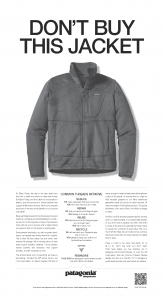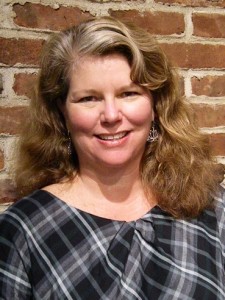
SAGE Magazine sat down to talk with Jill Dumain, Director of Environmental Strategy for Patagonia. Dumain visited the Yale School of Forestry and Enviromental Studies on September 23, along with Patagonia’s Vice-President of Marketing Vincent Stanley, to participate in a thoughtful discussion surrounding the company’s “Don’t Buy This Jacket” ad campaign. Dumain and Stanley shared their perspectives regarding Patagonia’s mission to reduce unnecessary environmental harm and achieve sustainable business operations in a resource-constrained world.
In the interview, Dumain offered telling insights about the company that she’s helped grow over the past 14 years. She described Patagonia’s role in sparking important dialogue about reducing consumption among the company’s employees, vendors, and consumers, in an age when consumers are demanding more transparency from businesses.
The following is a condensed, edited version of an interview with Dumain.
SAGE Magazine: When did Patagonia embrace environmental and social responsibility?
Jill Dumain: Our reputation for environmentalism goes back to the beginning of the company. Really, the company Patagonia was born out of, Chouinard Equipment, was the first time we changed the product line for environmental reasons. The original product, pitons, were damaging the rocks, and so moving to a product that was called a chock for climbing at the time was really a significant business decision for Chouinard Equipment, because the majority of their business was from pitons. So that sort of set the stage, and then you fast forward.
Patagonia was begun in ’73 along those lines of leaving no trace, but our reputation was really born out of giving money away to grassroots nonprofits. But then it was really in the late 80s, we started looking at, “Okay, we might be giving money to save a river here, but what are we doing with our dye house over here that might be sitting on a different river in a different part of the world?” They often weren’t in the same places. And so we started to investigate more about our internal processes in the late 80s, early 90s. And that’s when it really began, our earnest effort at making changes in our supply chain around environmental issues.
SM: Have you seen significant progress made in that direction since you started at Patagonia?
Dumain: Yeah, definitely. I was fortunate enough to be there from the beginning, having started in ’89. We were just doing development work just like any other company, and I was in our fabric division at the time and remained there for 14 years, my first 14 years with the company. We were buying cotton, just going after aesthetics and price and performance, like a lot of other companies, and then we started to learn about the environmental issues in our supply chain, whether it be growing cotton, doing dying and finishing, or considering what needed to be done concerning the end-of-life of our products. It became really apparent that we needed to focus on some of those things that we were doing to degrade the environment. What businesses and practices were we supporting? How do we start working and shifting some of that?
SM: You mentioned the grassroots activism that Patagonia supports. As Director of Environmental Strategy, how do the bottom-up and top-down approaches best compliment each other to achieve environmental sustainability?

Dumain: I think they’re both critical, but I don’t think it matters so much where it begins. I’ve come to care less where motivation comes from on why companies do this. I think some people get hung up that if it’s not pure motivation, then it doesn’t really count. And for me, I don’t care what the motivation is. If they’re making changes that result in a benefit from an environmental or social standpoint, then that’s great. And when I’ve been asked the question of, “Do you need the ground-workers and the worker bees, or do you need support from the top?” I think it usually starts in one of those places, and then the other one tends to get it. I think it really begins to gain traction when you have top and bottom. Often, the middle is difficult, but they usually get squeezed if you get the top and the bottom to get on the bandwagon of what’s happening.
So it’s hard to communicate up new ideas if you are the worker bee starting it. So often, I’ll encourage people to figure out what you can do that doesn’t impact the other business metrics. If it doesn’t increase costs, if it doesn’t decrease quality, but it brings this benefit, that’s a pretty good argument with which you can go up the chain and say, “Hey, we can do this.” Or the other side, if it comes from the top-down, often education is really what employees and colleagues react to. Once they understand the bigger context of what’s happening, it’s a pretty fun part of your job to add to it and be able to have that value set come to work with you.
SM: When thinking about employment opportunities, what can a student here expect when he/she looks at a position at your company? Can a student anticipate similar opportunities for innovation and really making a difference?
Dumain: A lot of times when I talk to students coming out of environmental programs now, I feel like there are a lot more students than there are jobs that have “environmental” in the title. I’ll often get calls around April or May: “Hey, can I pick your brain? I’m graduating.” And I started talking to people and saying, “Don’t worry about having ‘environmental’ in your title.” And I really try to encourage people to look at what they’re passionate about, what industry they’re passionate about. In the conversations I had this morning, everybody always had “I am interested in environmental and…” That “and” was always there, whether it was investment to supply chain issues, to agricultural issues, to fishing issues. So focus on that “and.” What is it you’re passionate about? Because you’re going to be good at that, you’re going to be motivated to work in that area that you are concerned about or passionate about. And then, if you can, get with a company that is doing some environmental work. It may not be in the environmental department, but if I had a new employee that started in finance and said, “Hey, my background also includes environmental, what can we do in finance to support the environmental mission of the company?” I would be ecstatic in that I don’t have to go out and convince people in these different departments that adding an environmental column to their business metric spreadsheet is important. It’ll be interesting to see, because it’s sort of a new element in this field of all these newly educated graduates coming out, where everyone falls in. But I’m excited by it because I think there’s going to be a shift in business when all of you are working across many departments and many businesses and trying to bring this information forth.
SM: When Patagonia assesses life cycles and how your suppliers can be a little bit more sustainable, who does that research?
Dumain: It’s a combination effort. When I was in the fabric department, I spent a lot of time in cotton fields, and I spent a lot of time recently in grasslands that sustain sheep to give wool. So we do spend a lot of time going into the supply chain. Down has been a really hot topic and a lot of my colleagues have visited numerous goose farms around the world and are learning about what it is and what we need to pay attention to, and educating ourselves on what is important. Our materials department – they spend a lot of time doing the same thing. As you go into the factories, our production and sourcing team – they travel there on a regular basis anyway for all their other issues.
SM: Patagonia seems to be pretty revolutionary in that consumers are now becoming so involved because they want to and they want to support a brand that is sustainable and demands that transparency.
Dumain: It’s the expectation. I don’t think it’s a choice anymore. I think it’s an expectation and I think a lot of things shift through business like that. Quality used to be a differentiating point – it’s an expectation now. And that’s where I feel like environmental work is going. It used to be a distinction and now it’s an expectation as we move forward.
SM: What inspired the shift from a focus on the symptoms of environmental problems to their core causes? And how does Patagonia plan to limit consumption but maintain profits?
Dumain: We don’t know the answer. But it’s beginning the conversation. The conversation is happening in academia, it’s happening in the NGO world, but it’s not really happening in business. It’s not the same level that we’re seeing in these other areas. We feel like our role as a for-profit company is coming in and starting the conversation from a business perspective and realizing, you know, forget all the environmental arguments, but we’re in a resource-constrained world and there are already starting to be business ramifications from resources being constrained whether it’s drought or fire.
Some of the big droughts in Texas a couple of years ago caused some of the big cotton users to shift product because the cotton couldn’t be grown. How do you plan, from a business standpoint, in these shrinking resources? For me, even internally, when people ask, “What’s the economic case – this all costs more?” Well, it costs more today, but is it going to cost more in 5, 10, 15 years? Are you going to have to shift your supply chain because you’re not working with vendors that are efficient with their resources? How does that play into it? How do we create what we need versus what we want in our society?
SM: The Common Threads Initiative seems to ensure that you confine your products to a sustainable life cycle. How successful is this program, and is it making a dent in resource use?
Dumain: Worn Wear is really new; it’s like 6 months old, so we don’t have a lot of metrics that are coming back yet. The initial results from the stores have been quite good and the sales staff is pleased with what they’re seeing. We haven’t had enough results yet to do a business analysis on a square-foot cost basis; it’s too new for that.
And the employees are very excited with the customer conversation that they’re having. It helps them to explore the tension of being a consumer goods, for-profit business and saying, “Don’t buy this jacket.” We’re creating our own tension, but getting people to think about it a little bit. That’s what we see – this role as a catalyst. A few years ago, I sort of started to realize that that’s a lot of our company’s role as a catalyst.
SM: So Patagonia is getting consumers to contribute to the conversation because the consumption problem is so complex that it can’t really be solved any other way?
Dumain: Absolutely. It needs a lot of engagement from a lot of different areas. But looking to the horizon, we see again, that’s a cause in this consumption model. The planet just can’t support it. Annie Leonard, from the Story of Stuff, has a quote that I love: “We’re going to change. We can decide: is it going to be by design or by disaster?” And choosing to change by design is a whole lot smarter than by disaster, but given where we’re going from a resource standpoint, it’s going to be one of the two.